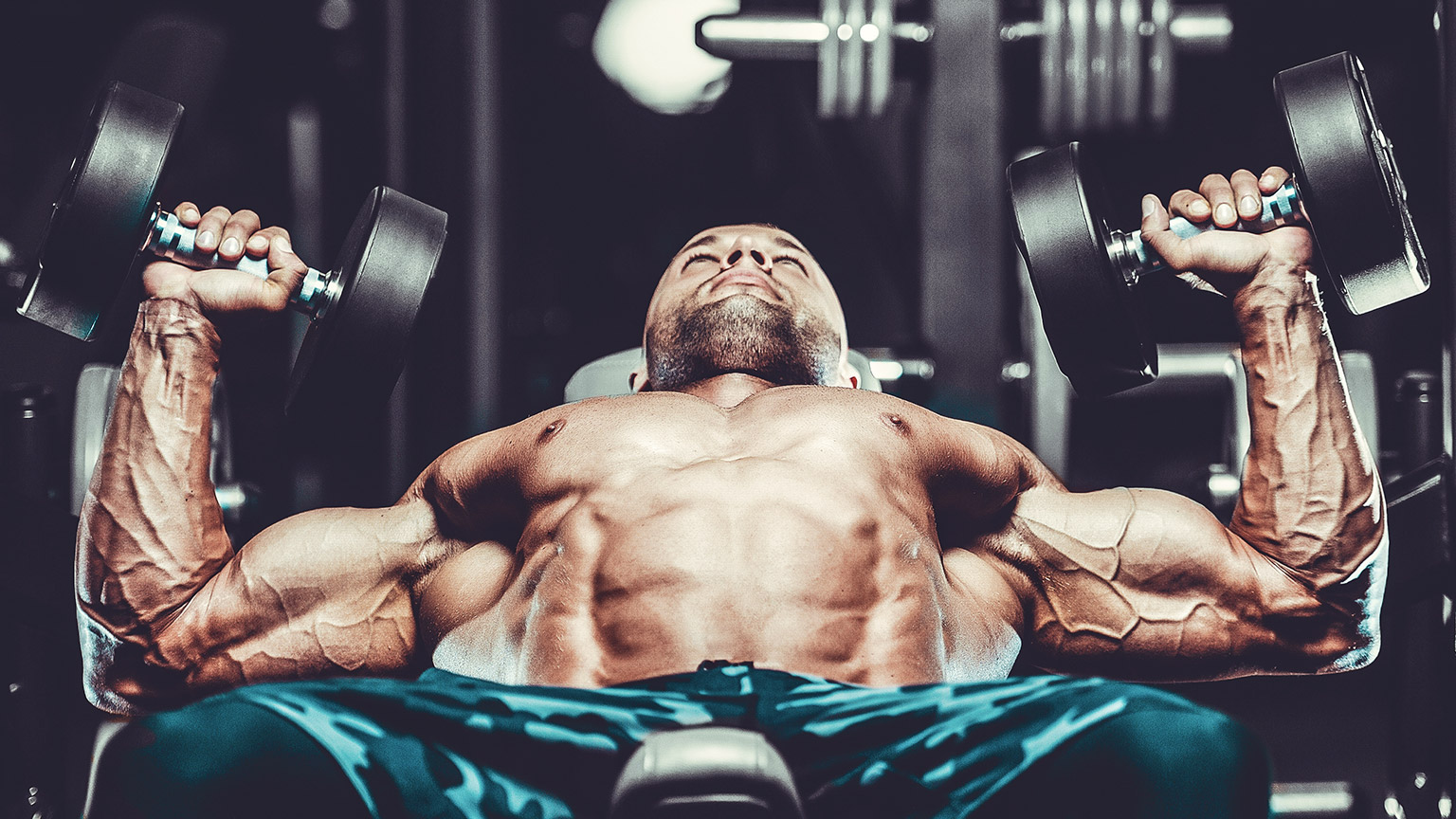In this topic, we focus on the structure and function of the muscular system. You will learn:
- key muscle terminology
- different muscle types and characteristics
- shapes of muscles
- types of muscular contractions
- locations and actions of muscles
- muscles and the exercises which target them.
Terminology and vocabulary reference guide
As an allied health professional, you need to be familiar with terms associated with basic exercise principles and use the terms correctly (and confidently) with clients, your colleagues, and other allied health professionals. You will be introduced to many terms and definitions. Add any unfamiliar terms to your own vocabulary reference guide.
Activities
There are activities throughout the topic and an end of topic automated quiz. These are not part of your assessment but will provide practical experience that will help you in your work and help you prepare for your formal assessment.
Although bones provide our body with a framework (a form of human scaffolding) our body would be unable to move with bones alone. That’s where the muscular system comes in. Movement is achieved by the coordinated contraction of muscle fibres (which therefore also incorporates the nervous system).
When you think of muscle, it's logical to think about them as the things we use to move around and manipulate our environment (and things we may want to grow and flaunt on the beach). The muscular system is responsible for far more than that.
Fun fact: The muscular system is constantly working (even when you are resting). Postural muscles keep you upright whilst sitting and standing, respiratory muscles keep you breathing, and the heart continually pumps blood around the body. Approximately 700 individual muscles of the human body take part in maintaining homeostasis.
As well as aiding our whole-body movement, muscles help move food and food waste through our digestive system and produce most of the body heat we need to stay alive.
Types of muscle
There are three main classifications of muscle in the human body:
- Skeletal muscles
- Cardiac muscles
- Smooth muscles.
Look at the following image which shows the differences between the three types.

Characteristics of muscle tissue
Let's identify some important points about the characteristics of each muscle type.
Skeletal muscle
- The skeletal muscle is so-named due to its location. It's called 'skeletal' because it attaches to the skeletal system (bones).
- It is also referred to as striated muscle because it appears striped under a microscope (due to myofilament alignment).
- Skeletal muscle is the muscle we use to move and manipulate our environment (for example, to pick things up, drive a vehicle, or play sport).
- Most skeletal muscle is classified as voluntary (this means it is mostly consciously controlled via the somatic nervous system (a small number are involuntary such as postural muscles).
Fun fact: Skeletal muscle constitutes approximately 40% of body weight.
Cardiac muscle
- Only the heart contains cardiac muscle.
- Cardiac muscle, like the skeletal muscle, is also striated.
- Cardiac muscle is classified as involuntary (pretty lucky we don’t need to think of contracting our heart to pump our blood around our bodies). It works via auto conduction using its own pacemaker, a process referred to as 'auto-rhythmicity', and continues to beat at the same pace until neurotransmitters or hormones intervene and increase or decrease the heart rate.
- The main function of the heart is to pump blood around the body.
Smooth muscle
- Smooth muscle is named for its appearance under a microscope. Unlike cardiac and skeletal muscle, it is not striated, it appears smooth under a microscope.
- Both cardiac and smooth muscles are regulated by the autonomic (involuntary) division of the nervous system. In other words, you cannot control it consciously (directly).
- Most smooth muscle is found around and within internal organs and walls of hollow structures. For example, in the walls of the digestive, respiratory and urinary systems and in the walls of veins and arteries.
- The contraction of smooth muscle is 'wave-like' and called peristalsis.
The following video will explain these points in more detail.
Properties of skeletal muscle
Properties of skeletal muscle (not to be confused with characteristics of skeletal muscle) are hugely important when it comes to having a sound science behind program design.
Muscle tissue has four special properties that enable it to function and contribute towards achieving and maintaining homeostasis.
- Contractility: Contractability is the ability of the muscle to shorten with force. When skeletal muscles contract, they generate tension, causing movement of the structures to which they are attached (usually bone). It is important to note that muscles only pull on bones, they do not push.
- Excitability (electrical excitability): Excitability is the capacity of skeletal muscle to respond to stimulus. They are stimulated by nerve impulses (electricity) sent by the nervous system and chemicals such as neurotransmitters and hormones that are distributed by the blood.
- Extensibility: Extensibility refers to a muscle's ability to be stretched within its limits without being damaged.
- Elasticity: Elasticity is the ability of the skeletal muscle to 'recoil' to their original resting length after contraction or extension.
Functions of skeletal muscle
Through its ability to contract and relax, muscular tissues have five main functions.
- Produce body movements: This includes whole-body movements like walking or running and also more precise movements such as picking up a pencil and nodding your head.
- Support: Skeletal muscles support internal organs, stabilise the spinal column and maintain posture by holding joints in place.
- Store substances: Storage of substances is achieved by circular muscles called 'sphincters'. For example, to prevent outflow from organs and enable the temporary storage of substances in organs such as the urinary bladder and stomach.
- Protection: Sphincters of the eyes, mouth and other orifices also prevent outside foreign bodies from entering the body (for example, dust in your eyes). Muscles can also protect internal organs that don't have the benefit of bony coverings (such as abdominals)
- Heat production: Approximately 85% of body heat is produced by muscles. As muscles contract heat is produced through a process called thermogenesis. Contrary to popular belief, this heat production is not the result of friction. When muscle contracts and uses energy, heat is produced as a by-product of cellular metabolism. When you are cold, your body will initiate this without conscious thought (for example, shivering).
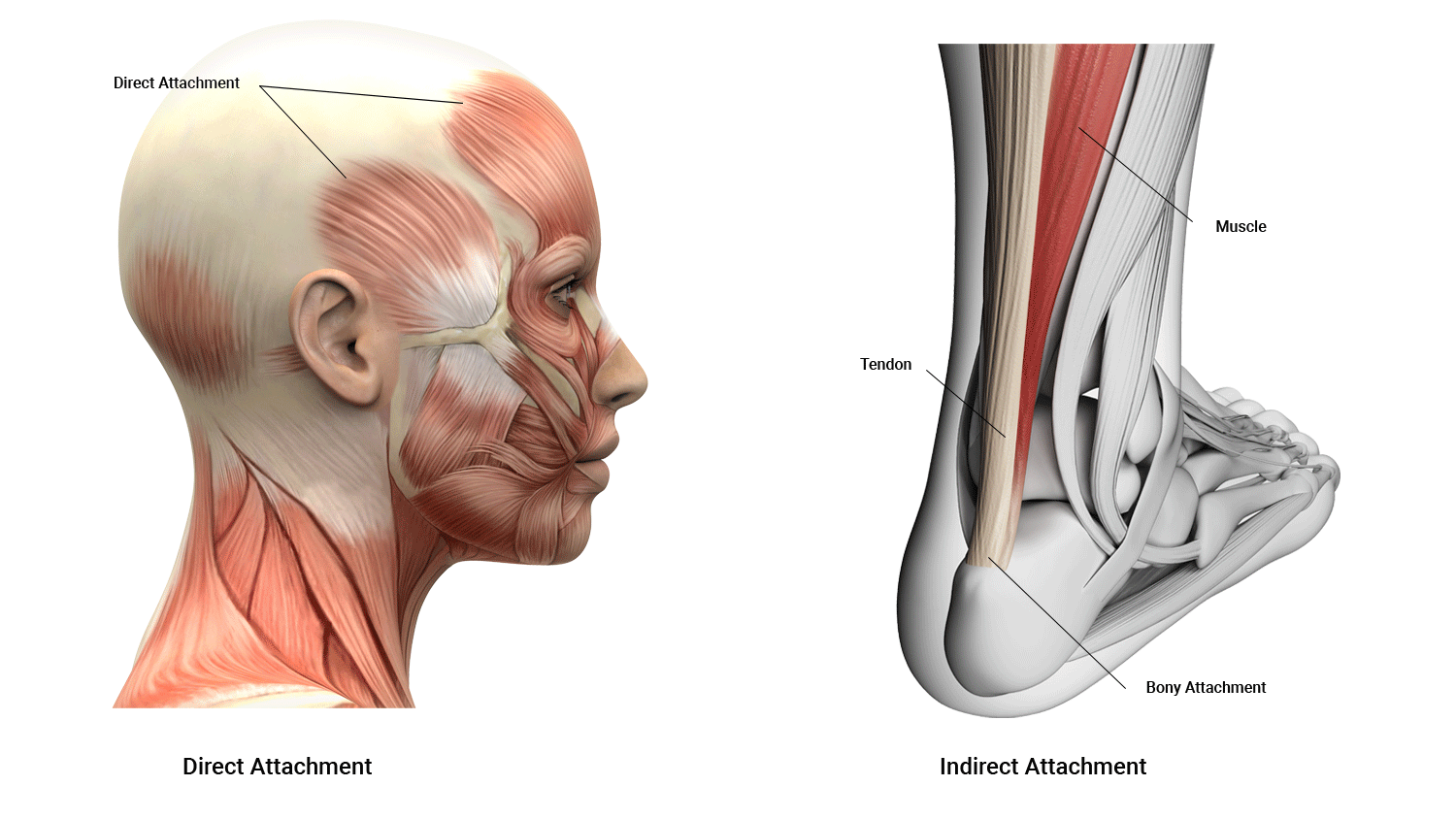 Muscle attachment
Muscle attachment
Skeletal muscles can attach to bones in a couple of different ways. These are:
- direct attachment
- indirect attachment.
Let's look at what these terms mean.
Direct attachment
Direct attachment is where the muscle grafts directly into the bone. This occurs in places where tapering into a tendon is not possible, such as in the muscles of the jaw and forehead. It usually occurs in muscles that need to attach along the length of a bone.
Indirect attachment
Indirect attachment is where skeletal muscles attach to the bone via tendons (as is the case of most muscles). Tendons are tough cords of collagen fibres that grow directly from the muscle fibres.
Muscle forms and key terms
Muscles come in many varied shapes and sizes depending on their location and function, as you can see from the following diagramme.
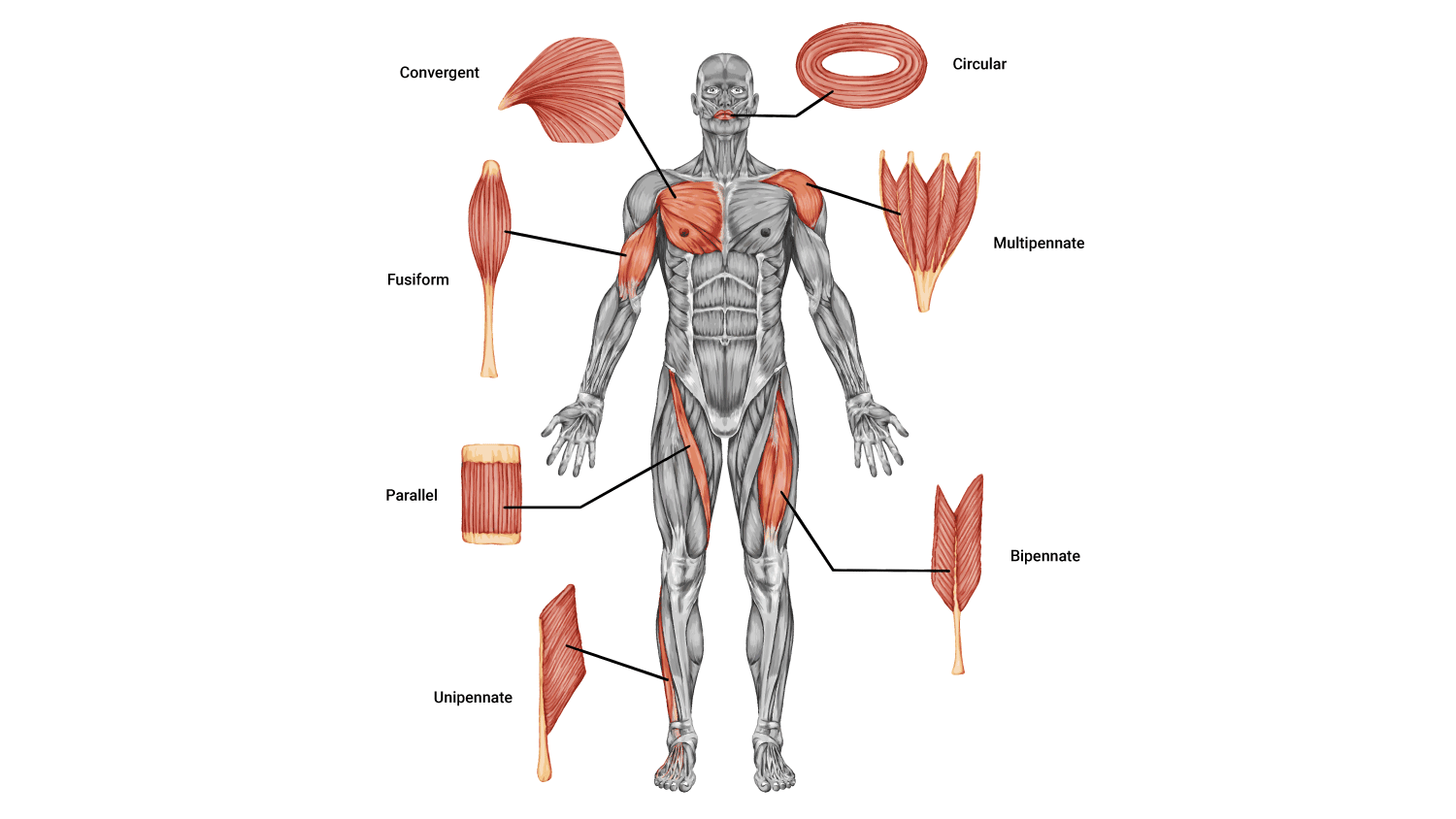
Muscle fibres and the corresponding muscle shapes
Let's define the labels on the preceding diagramme.
Fusiform
Fusiform is when all fibres run in one direction and taper at each end. For example, biceps brachii, quads, and hamstrings.
Parallel
Parallel is when the fibres run in one direction and can be separated into compartments. For example, the rectus abdominous.
Convergent
Convergent is when the fibres have a wide origin tapering off to a narrow insertion. For example, the pectoralis major and adductor muscles. Allows contraction from different angles.
Unipennate
Unipennate is when the fibres run in one direction but are of different lengths and graft directly onto the bone. For example, palmer interossei (adducts fingers).
Bipennate
These are feather-like fibres that run in two different directions which attach into a central line of fascia. For example, the rectus femoris (quadricep).
Multipennate
Multipennate fibres run in multiple different directions allowing multiple movement planes. For example, the deltoid.
Circular
These are ring-shaped muscles that squeeze shut or open and are often known as 'sphincters. For example, the obicularis oris (pinches mouth closed) and the obicularis oculi (squeezes eye shut).
This sub-topic covers a number of key terms that are necessary for you to learn so that you have a solid understanding of the workings of muscle. We will also look in-depth at the types of contractions they can perform. Make a note of these terms and keep them handy. This will be vocabulary you will use every day, several times a day in your fitness career with both clients and colleagues.
Muscle attachment sites
Look at the terms and their locations in the following diagramme.
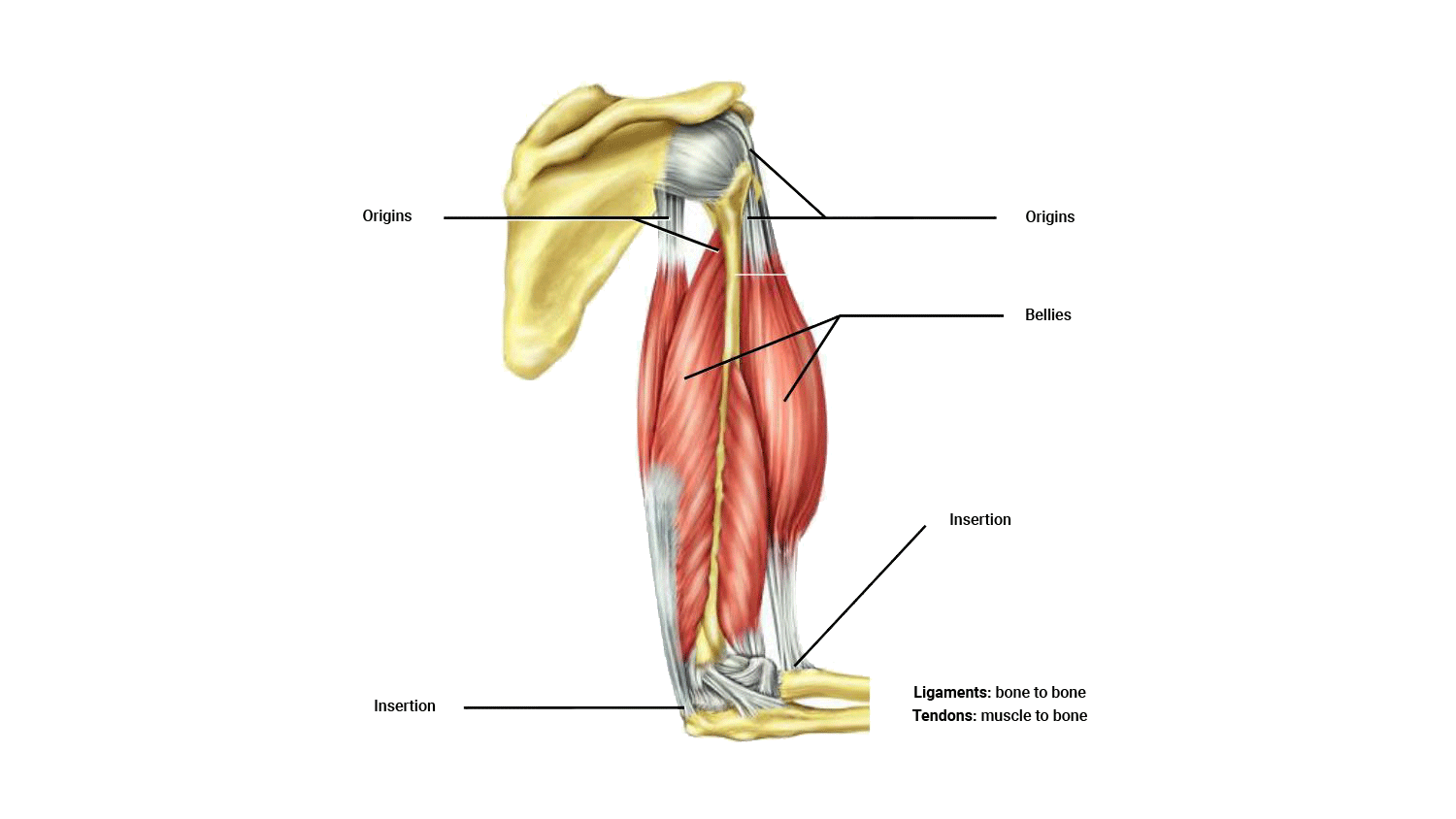
Let's now discuss what is meant by these labels.
Origin and insertion
- Origin: The anchor for contraction does not move during contraction. The term origin refers to the site of attachment of the muscle’s tendon to the stationary bone.
- Insertion: This refers to the attachment site of the muscle’s tendon to the movable bone. When the muscle contracts, it brings the insertion closer to the origin (for example, think of a bicep curl involving the bicep). When the action is performed, the distal insertion on the forearm is pulled towards the proximal origin in the shoulder.
- Belly: Also known as 'body'. This refers to the fleshy part (region) of the muscle between the muscle tendons. This is typically the widest part of the muscle.
Muscles can, but seldom do work in insolation. They usually work in pairs. Below are a variety of partnership styles muscles have together. It is very important to be comfortable with these and keep these relationships in mind when prescribing exercises. Read through these terms, write them down and practice using them in your personal fitness terminology and vocabulary reference guide.
Agonist and antagonist
These two terms are very important in understanding how muscles on opposite sides of a joint interact together.
- Agonist: The agonist is the prime mover, the targeted muscle or main muscle working in a given exercise.
- Antagonist: The antagonist is the muscle that works against the agonist (provides resistance and stabilisation of movement).
Example: Bicep curl
- Agonist (prime mover) = bicep
- Antagonist = tricep
The role of the antagonist
The antagonist's role is often confused. It generally only plays a role when moving without resistance. When lifting a weight, the weight itself is the antagonist (providing resistance against which the agonist works).
When no external resistance is present. For example, when using your bicep to lift a cup of coffee, the triceps must provide some resistance so that the biceps have something to work against. Without this antagonistic resistance, it would be difficult to control the movement.
Synergists and fixators
While the agonist and antagonist are of primary importance in movement, they can't do it on their own. Other muscles play vital support roles that enhance movement quality.
- Fixator: The fixator muscle stabilises the bone/joint during contraction. It keeps movement in one plane and ensures movement is efficient.
- Synergist: The syngergist muscle assists the prime mover by reducing any unnecessary movements.
Example: During a biceps curl the biceps brachii are the prime movers. The brachialis are the synergists (assist the movement). The deltoid and forearm muscles are the fixators that stabilise the shoulder and bones of the forearm, so the movement is completed in one plane and is efficient.
Muscles can contract in a number of different ways. There are three main contraction types:
- Isotonic contraction
- Isometric contraction
- Isokinetic contraction
Isotonic Contractions
Muscle contraction is where a muscle shortens and lengthens while producing force. It is made up of two phases:
- Concentric: The muscle shortens as it creates force.
- Eccentric: The muscle lengthens as it produces force.
Concentric and eccentric phases
These are commonly seen in gym lifts.
- The concentric phase can be thought of as the work phase where the weight is lifted, the phase of the movement which is overcoming gravity. Whenever a weight goes up in the gym, that is the concentric phase. Note that sometimes you 'pull-down' in the gym, to get the weight to lift, such as when you perform a lat pull-down.
- The eccentric phase is the release phase where weight is lowered under control, resisting the load or the effects of gravity.
A common misconception...
Many people think that during a gym lift the agonist works on the 'lift' portion of the exercise, while the antagonist works on the down phase. For example, during a biceps curl the biceps work on the up phase and the triceps work on the down phase. This is incorrect!
Think about it for a minute. If the triceps worked on the down phase of a biceps curl the elbows would extend rapidly (instead of under control). We don't need to engage the triceps as gravity wants to return the weight towards the floor. Instead, the biceps must work (eccentrically) to control the rate of descent.
The same is true of any weighted gym lift, or movement against gravity. We use concentric contraction of the agonist to lift the weight, then eccentric contraction of the agonist to return the weight to the starting position under control. So the same muscles are targeted in both phases of the lift.
Examples of isotonic contractions include stair climbing, push-ups and squats to name a few. When looking at a bicep curl in terms of concentric and eccentric phases, the concentric phase of a bicep curl would be raising the dumbbell towards the shoulder, away from the ground, overcoming gravity to lift the weight upwards, away from the floor. The eccentric phase would be the safe lowering movement, bending at the elbow, and controlling the movement back towards the floor/resting or starting position of the movement.
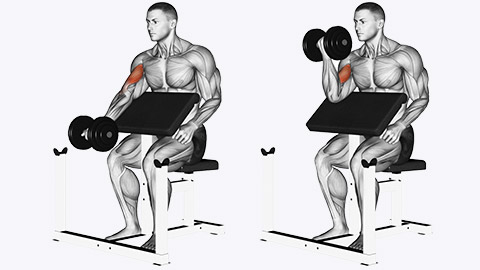
Isometric Contraction
An isometric contraction is a muscle contraction where the muscle produces force but does not change length (for example, a prone hold (plank) or wall sit). Obviously, muscles suited to endurance work would be best at this type of contraction. Postural muscles use isometric contractions to keep body parts upright (against gravity). For example, back extensors and deep abdominals supporting the spine in sitting and standing.

Isokinetic Contraction
During this type of contraction, the length of the muscle changes but the force is produced at a constant velocity in both movement directions. Imagine doing a gym exercise but being resisted in both directions; for example, if you are performing a seated leg extension followed by a seated hamstring curl on the same machine in one (1) rep.
This type of training requires specialised machines. Typically, the amount of resistance is dictated by the amount of force the athlete produces. That is, the harder you push the more it resists in order to keep the velocity of the movement constant.
Isokinetic exercises are typically used most often in recovery and physical rehabilitation and these machines are rarely seen in a gym environment.
The following picture below is for you to practice your muscle location knowledge. See if you can name each muscle and the main actions that each muscle is responsible for.
These muscles are the top 20 muscles you will refer to in your fitness career, becoming comfortable with these and their actions is paramount. There are a lot of names ( some strange names) to remember, write these down and test yourself.
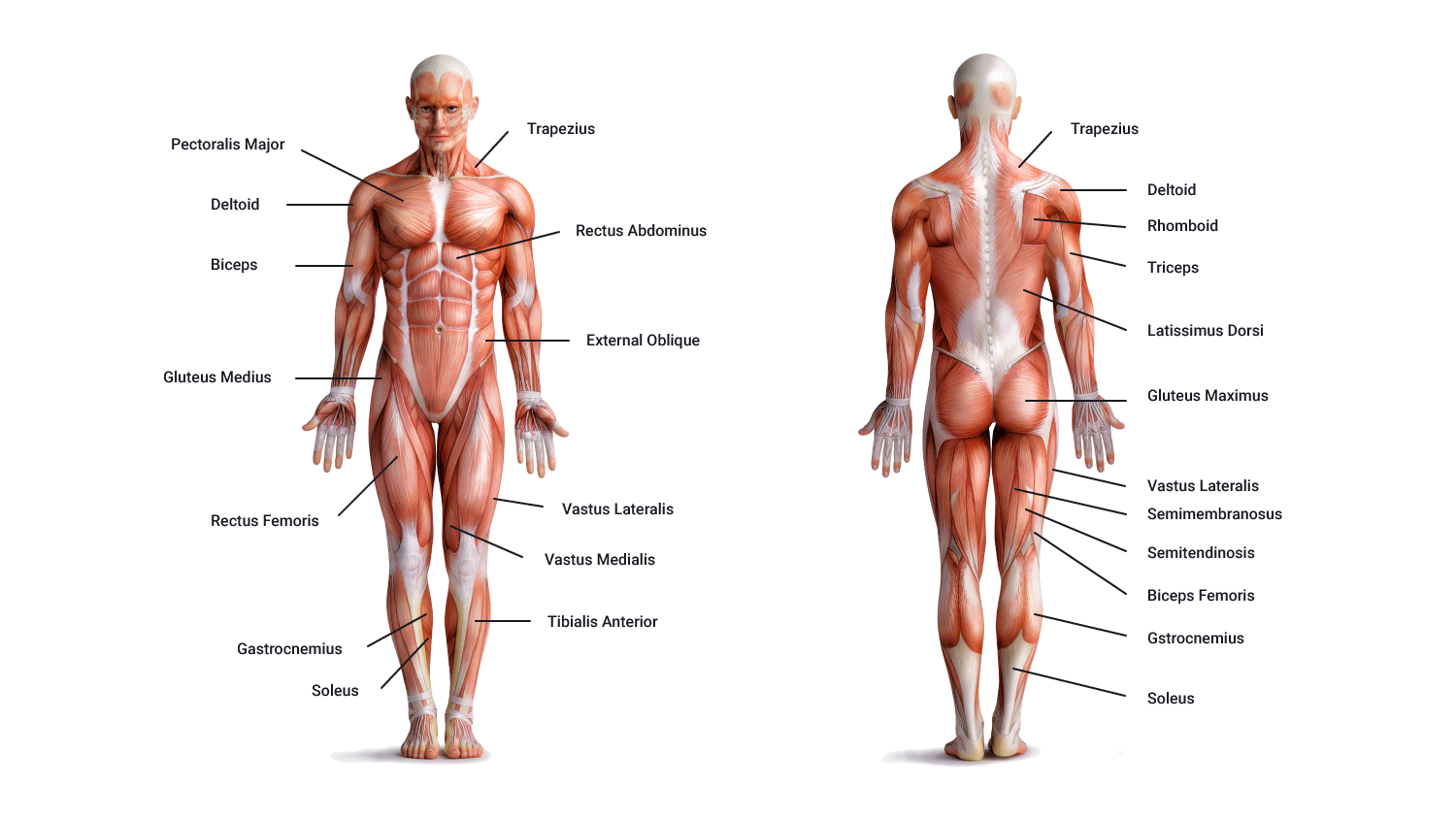
| Muscle group | Muscle | Major Action of muscle |
|---|---|---|
| Calves | Gastrocnemius | Ankle plantar-flexes, ankle flexes knee |
| Soleus | Plantar-flexes ankle | |
| Hamstrings | Biceps femoris | Flexion |
| Semitendinosus | Flexion | |
| Semimembranosus | Extension | |
| Gluteals | Maximus | Extension |
| Medius | Abduction | |
| Chest | Pectoralis Major | Horizontal adduction |
| Back | Lattisimus dorsi | Adduction Extension |
| Arm | Biceps Brachii | Flexion |
| Triceps Brachii | Extension | |
| Quads | Rectus Femoris | Flexion |
| Vastus lateralis | Extension | |
| Vastus medialis | Extension | |
| Abdominals | Rectus abdomnus External obliques |
Flexion extension rotation Stabilisation of spine |
| Shoulder | Deltoids | Flexion abduction extension |
| Trapezius group | Elevation retraction depression | |
| Tibialis anterior | Ankle dorsiflexion Inversion of foot |
|
| Hip adductors | Adduction Medial rotation Flexion of thigh |
Below is a comprehensive list of the main muscles you will focus on in this module.
This list highlights the joints they act on, their major action, and a sample of exercises that will target these muscles. It is important for your career that you learn and become comfortable reciting the information in this table. This information will pay dividends in the knowledge that you draw on every day with your clients and with your programme design rationale. Becoming comfortable with the exercises that target these muscles, the joints involved and the actions these muscles produce will enhance your fitness prescription and comfort when working with individuals. Practice, practice practice!
Muscle Top 20 Fact Sheet
| Muscle | Gastrocnemius | Soleus |
|---|---|---|
| Joint/bone muscle acts on | Ankle/knee | Ankle |
| Major action of muscle | Ankle plantar-flexes ankle Flexes knee |
Plantar-flexes ankle |
| Sporting/gym movement example | Standing calf raise | Seated calf raise |
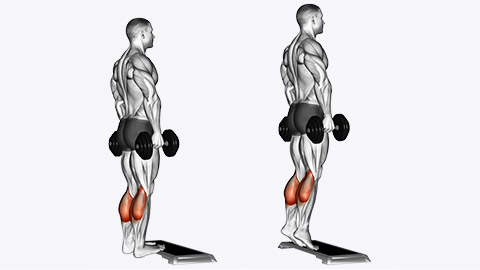
| Muscle | Biceps femoris | Semitendinosus | Semimembranosus |
|---|---|---|---|
| Joint/bone muscle acts on | Knee | Knee | Hip |
| Major action of muscle | Flexion | Flexion | Extension |
| Sporting/gym movement example | Hamstring curls | Hamstring curls | Deadlift |


| Muscle | Maximus | Medius |
|---|---|---|
| Joint/bone muscle acts on | Hip | Hip |
| Major action of muscle | Extension | Abduction |
| Sporting/gym movement example | Squats, leg press | Hip abduction (cable) |
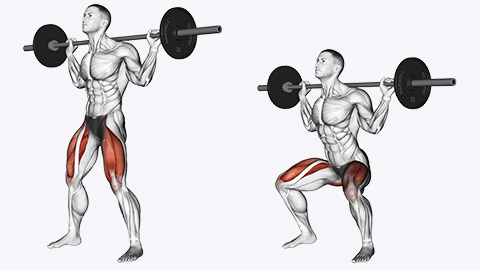
| Muscle | Pectoralis major |
|---|---|
| Joint/bone muscle acts on | Shoulder |
| Major action of muscle | Horizontal adduction |
| Sporting/gym movement example | Chest press |

| Muscle | Lattisimus dorsi |
|---|---|
| Joint/bone muscle acts on | Shoulder |
| Major action of muscle | Adduction Extension |
| Sporting/gym movement example | Lat pulldown Seated row |

| Muscle | Biceps brachii | Triceps brachii |
|---|---|---|
| Joint/bone muscle acts on | Elbow | Elbow Shoulder |
| Major Action of muscle | Flexion | Extension |
| Sporting/ gym movement example | Biceps curl | Tricep pull down ( able) Straight arm pullback (cable) |


| Muscle | Rectus femoris | Vastus lateralis | Vastus medialis |
|---|---|---|---|
| Joint/bone muscle acts on | Hip | Knee | Knee |
| Major Action of muscle | Flexion | Extension | Extension |
| Sporting/ gym movement example | Hanging leg raise | Leg extensions Squats |
Leg extensions Squats |

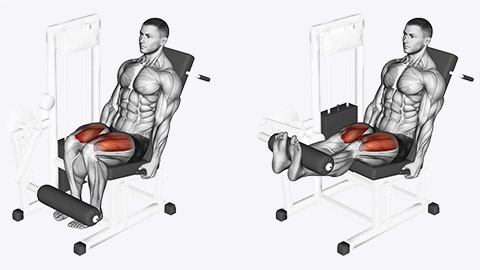

| Muscle | Rectus abdomnus External obliques |
|---|---|
| Joint/bone muscle acts on | Vertebra |
| Major Action of muscle | Flexion Extension Rotation Stabilisation of spine |
| Sporting/ gym movement example | Sit-ups Side bends Russian Twist Prone Hold |
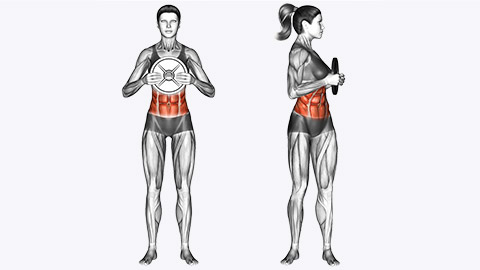
| Muscle | Deltoids | Trapezius group |
|---|---|---|
| Joint/bone muscle acts on | Shoulder | Scapula |
| Major action of muscle | Flexion Abduction Extension |
Elevation Retraction Depression |
| Sporting/gym movement example | Front raises Lateral Raises Rear delt Flies |
Shrugs Seated row (no exercise relation to depression of scapula) |


| Muscle | Tibialis anterior | Hip adductors |
|---|---|---|
| Joint/bone muscle acts on | Ankle | Hip |
| Major Action of muscle | Ankle dorsiflexion Inversion of foot |
Adduction Medial rotation Flexion of thigh |
| Sporting/ gym movement example | Walking/jogging/running Dorsiflexion performed with a resistance band. |
Seated hip adduction (machine) Standing hip adduction |
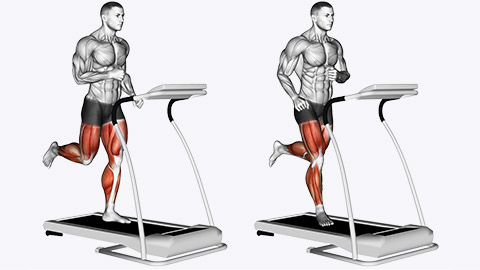
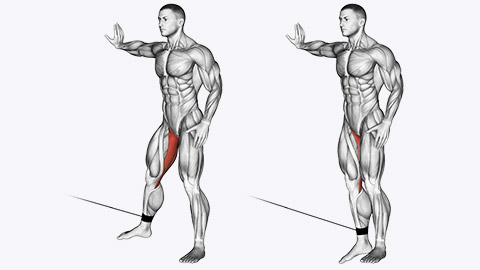
In this topic, we focused on the structure and function of the muscular system. You learnt about:
- key muscle terminology
- different muscle types and characteristics
- shapes of muscles
- types of muscular contractions
- locations and actions of muscles (particularly the top 20 key muscles)
- muscles and the exercises which target them.
